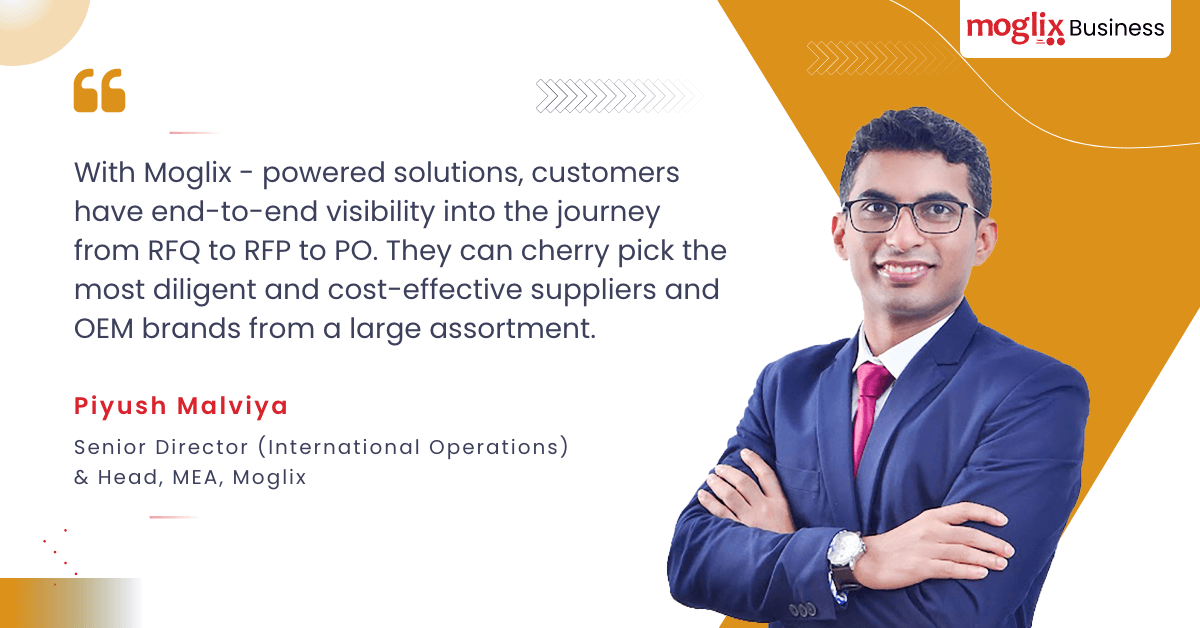Moglix – Reimaging manufacturing infrastructure in the UAE

Moglix – Reimaging manufacturing infrastructure in the UAE
UAE lies at the crossroads of the manufacturing supply chain routes that crisscross across the world. Technology penetration in the Middle East region has already attained a threshold level which is visible from the success of B2C e-commerce. So, technology adoption is not a challenge. Rather the challenges we have been resolving in the Middle East are those related to limited product assortment of suppliers, costs of distribution, warehousing, and logistics, and enabling manufacturers realize their mandate for creating end-customer value.
Since launching in the UAE, we have channeled existing partnerships to secure symbiotic collaborations across manufacturers, suppliers, distributors, specialists, and consultants. The B2B e-commerce platform, moglix.ae, provides a catalog of over 500,000 industrial products spanning 50+ categories. It provides insights on metrics like the expected time of arrival, lead time, and the turnaround time. Such data enables agility at scale in procurement decision-making frameworks for customers and suppliers. They ensure that end-to-end supply chains can withstand macroeconomic shocks and disruptions.
Silver bullet to mitigate Supply Chain Disruptions

Silver bullet to mitigate Supply Chain Disruptions
The manufacturing sector in the middle east, prior to the pandemic, relied on a highly fragmented supplier base, and with a few exceptions, it wasn’t standard practice to replace the many suppliers with a few or just one. A manual and relationship-led procurement and supplier management process meant limited adoption of digital tools such as ERP systems. COVID-19, though has been an epic tipping point for the intense digital transformation of the supply chain industry in the Middle East region.
According to market analysts Ventures Middle East, digital transformation initiatives in supply chain have become increasingly powerful and businesses that make use of it are expected to stay resilient. The Gulf Cooperation Council (GCC) countries are expected to continue to invest heavily in digital transformation solutions in supply chain as it tries to enhance its position as a hub for international commerce in a pandemic scenario as well.
Well-planned and well-implemented digital transformation offers the opportunity to leapfrog to a new, digitally-enabled future ahead of competition, crises, and most importantly, customer expectations.
Next for Digital Supply Chain Transformation: Connectivity, Convenience, and Analytics
The dramatic shift towards a digital supply chain has been all too evident post-pandemic, with a full realization that it not only makes them more competitive and resilient – there is also an economic upside.
The India-UAE CEPA: A Progressive Step

The India-UAE CEPA: A Progressive Step
Inked on February 18, 2022, the Comprehensive Economic Partnership Agreement (CEPA) between the United Arab Emirates (UAE) and India is a massive leap forward in the bilateral trade relations between the nations. The agreement is set to usher in a plethora of benefits for both the signatories.
What is The India-UAE CEPA?
The India-UAE CEPA is a bilateral free trade agreement between the nations that came into effect on May 1st, 2022. The CEPA has been envisaged as raising the total bilateral trade between the nations from $60 billion to $100 billion (for goods) and $15 billion (for services) over a five-year period.
With the CEPA coming into effect, there is set to be growth in the total value of bilateral trade as well as benefits in terms of technology exchange, movement of natural persons, government procurement, dispute redressal, and digital procurement, to name a few.
In addition to advantages on the economic front, the India-UAE CEPA is set to drive improvement in access to education, environmental protection measures, cultural exchange, etc. The landmark trade agreement has been projected to generate jobs in excess of 1 million across various sectors, for instance, agriculture, jewelry, and pharmaceuticals.
The Benefits of the CEPA for the UAE
The CEPA between the UAE and India is set to usher in the following significant benefits for the former.
1. Greater access to the Indian Market: The CEPA will provide more than 100 sub-sectors in the UAE access to the Indian market vis-a-vis the trade of goods and services. The UAE is set to gain preferential access on more than 90% of India’s tariff lines, particularly those related to exports.
2. Enhancement of Food Security: The agreement is a pivotal measure to address the UAE’s issues pertaining to food security. Through the establishment of a ‘Food Security Corridor Initiative’, there will be a comprehensive partnership and strategic procurement to improve the country’s logistical network for food.
3. Collaboration in the Education Sector: The CEPA also has provisions for collaborations between nations in the education sector. One of the cornerstones of this collaboration shall be the establishment of a first-of-its-kind Indian Institute of Technology on foreign soil – in the UAE.
4. Strategic Partnerships in التكنولوجيا Sharing: The India-UAE CEPA has also been envisaged as a harbinger of an increased sharing of technological know-how and infrastructure between the signatory nations.
Choose a Consummate Player to Optimize your Procurement Process
The India-UAE CEPA is a significant step forward in the bilateral trade ties of the nations. And manufacturers and exporters in the UAE and India alike can benefit from access to a bigger and more diversified market, profitable strategic partnerships, and sharing of tech initiatives and innovations. A future focused organization like Moglix with its tech led B2B supply chain ecosystem can play a pivotal role in welcoming CEPA to the next phase of growth. To know more about how Moglix can augment and optimize the procurement process, click here.
The Global Supply Chain Crisis: What’s in store for 2022?

The Global Supply Chain Crisis: What’s in store for 2022?
We wish there was good news. We wish there were even regular news. Alas, as we have gone deeper into 2022, our crystal ball does not have the clarity to report. Just as we’re hoping that we are seeing the back of COVID19 disruptions in global economic trade, supply chain, and logistics, we can already see new crises on the horizon.
Market Sentiment, Challenges, and the Supply Chain Connect
Last week, the International Monetary Fund (IMF) downgraded its global economic growth forecast by half a percent to 4.4. In doing so, it cited supply chain issues as a primary reason that is pulling the optimism around growth downward.
It’s not that the pandemic-related issues are simply going to vanish, but that the fragility of our supply chain ecosystem stands exposed. We also heard of COVID19 shutdowns in China, a vital piece of the global supply chain jigsaw puzzle. Expect the unexpected.
The world is also acutely aware of the conflict in Eastern Europe and its implications on global supply chains. The cross-border war has fractured the global manufacturing supply chain community into diverse groups, impacting import-export schedules, and affecting embargos, trade routes, and more.
On the other hand, the standoff between the two major economies of Asia is adding to the woes of local manufacturers and suppliers. It has given rise to a race – to gain supremacy and control on the best maritime trade routes to enable predictable, safe, and cost-effective movement of goods.
The 4Ms of Global Supply Chain Diversification as a Response
In short, we could all use a breather. A 4-M model could provide respite for organizations exposed to the intricacies and lack of predictability in the supply chain.
- Multi-Commodity: It is time for organizations to look at a broader range of products to diversify risk and tide over difficult times. By going wide and searching for alternatives, we can insulate ourselves against geopolitical risk and region-specific blockades to a more considerable extent.
- Multi-Supplier: As the name suggests, manufacturers should look at a broader supplier base for the same materials. While this may seem counter-productive for vendor management, the risk of receiving critical supplies from a select group of vendors is more dangerous.
- Multi-Modal Logistics – We must look at a more flexible and robust combination of logistics modes rather than depend on the tried and tested formula. The choice between air, land, and sea must be balanced to avoid last-minute surprises.
- Multi-Routes – Organizations are advised to select a combination of safer routes (green/yellow classifications) to ensure supplies emanating from different geographical areas do not face disruption.
In essence, in the coming years, businesses need to be resilient and flexible so they can be better at anticipating, reacting, planning, and recalibrating against the unexpected by developing long-term strategies and solutions; and enabling cross-functional integration and collaboration within their ecosystem of vendors.
Understanding the depth of your procurement and supply chain database by automating the collection, integration, analysis, reporting, alerting, and visualization of your supply chain data can help you recognize risk early and actually do something about it.
To experience an increased visibility and transparency in your operation process, let your sourcing and procurement teams have access to real-time visibility and data so they can be gung-ho!
Avengers Assemble: Manufacturing Technologies as Superheroes

Avengers Assemble: Manufacturing Technologies as Superheroes
While the future of manufacturing is endless; today UAE is at the helm of all digital transformations and an emerging manufacturing leader from the COVID19 pandemic endgame within the Middle East and North Africa (MENA) region. Just like Avengers are a group of superheroes working together – that defines an individual collaborative ‘single platform’ solution, Batman is the new kid in the manufacturing block leading the forces towards the technological future we deserve.
While there are multiple competitive businesses rising within the horizon, like a phoenix born to life, manufacturing ‘futuristic’ technologies just like the Marvel series is an individual solution for all manufacturing supply chain management needs.
The UAE Economic Vision 2030 seeks to shed this tag. As the world grapples with the aftermath of the pandemic, UAE aims to invest more in adopting advanced technologies to establish itself as a world-class manufacturing hub for decades to come. The Government has an ambitious aim to increase the contribution of manufacturing in the GDP from 11% to 25%. It seems that this enormous task befits the Avengers from the Marvel Cinematic Universe.
The Avengers Assemble: Know the Start Cast of Manufacturing Technology Superheroes
Dubai’s commitment to adopt the latest manufacturing technologies like artificial intelligence, machine learning, 3D Printing, and Smart Manufacturing is directly responsible for its rise as a global technology and innovation hub. This blog aims to equate these cutting-edge technologies to pop culture Avenger superheroes. The UAE seeks to assemble an ensemble cast that ushers in a new era of success.
Smart Helmets/3D printing – Enter Iron Man
Dubai is one of the world’s foremost travel hubs, with nearly a billion footfalls every year. The pandemic posed a considerable challenge to ensure proper safety protocols and healthcare access. Just like Iron Man has a Jarvis-enabled helmet, Dubai equipped staff with thermal helmets that allowed them to scan more than 200 travelers per minute. Innovative 3D printing technologies ensured there was no shortage of face shields. Just like Iron Man likes to tinker in his lab, Dubai is fast becoming a hub for product design and digital transformation.
4th Industrial Revolution (4IR) – Age of Ultron
A global revolution was exactly what Ultron had planned. The Ministry of Industry and Advanced Technology push is instrumental in the set-up, deployment, and investment into AI/ML, robotics, big data, and alternative energy sources. 4IR is also directly linked to supply chain efficiency and resilience. Talent and skilled resource development are also a must if the UAE is serious about creating the type of impact that Ultron had envisioned.
Laser Testing and Processing – Vision for a Vision
Dubai and the large cross-section of UAE geographies are fast building a reputation as a source for precision engineering and laser testing. The credibility set can help unlock the true potential of industry hubs like energy, chemicals, plastics, metals, heavy manufacturing, healthcare and electrical equipment, with a renewed focus on agri-tech, biotech, advanced manufacturing and space.
Digital Procurement akin to the Silver Surfer
It is essential to connect unto our conversations to measure RoI, social impact, and sales tools that enable you to go out individually. Catalog-based buying, digitalization of data, and procurement operations are the long-term answers, especially after the last two years of supply chain disruptions. Just like the Silver Surfer possesses speed, agility and the ability to harness limitless energy, digital procurement platforms will help UAE bring supply chain transformation to introduce deep tech investments over the next ten years.
What’s Next for the Avengers Assemble? A Window to the UAE in 2032
The UAE economy has expanded 57 times in the last five decades, rising from Dh6.5 billion to about Dh353.90 billion in 2020, on the back of burgeoning services and industries. And as the recently-released Dubai 2040 urban development master plan suggests, there will be continued investment in physical infrastructure as well, including transport, housing and leisure facilities to improve the quality of life for residents and to make Dubai a desirable place to live and work in the coming decades.
The UAE has been adopting new technology for greater digital advancement and applying it well in various sectors. And as digital integration takes the center stage, the UAE will continue to move towards and adopt collaborative ways of working in procurement and B2B commerce.
Moglix is an Asia-based B2B commerce company specializing in the e-procurement of industrial products. We provide digital procurement and supply chain solutions across industries, such as FMCG, Healthcare, Construction, Oil & Gas, Metal & Mining among others. To know how your enterprise can unlock the benefits of new-age technology-driven procurement and supply chain solutions from Moglix, visit https://business.moglix.ae/contact-us/
Have You Explored These Performance Enablers for Your Procurement Team?

Have You Explored These Performance Enablers for Your Procurement Team?
While the world is still seemingly adapting to the rapid digital advancements, post-pandemic, there has been an even greater push on digitization to take center stage in procurement teams. This change has encouraged companies to remake their supply chains and is poised to think about how digital transformation plays a vital role in how the procurement function delivers value.
According to a recent study by WBR Insights, most procurement leaders in the middle east are investing less than 50% of their budgets in future technologies like artificial intelligence (AI), machine learning (ML), robotic process automation (RPA), cognitive procurement tools and more.
Strategic sourcing is becoming more predictive, transactional procurement is becoming more automated, and supplier relationship management is becoming more proactive.
A report by Gartner stated that more than 70% of sourcing and procurement professionals report using suppliers to tap into new-in-kind technology services and something outside their organization’s core business model.
Procurement is all set to become seamless and frictionless like never before, especially in the UAE. The recent announcement of the ‘Centennial 2071 project’ plans to make UAE the best country in the next 50 years and hopes to enable future generations to live a happier life with a better overall environment, more significant growth opportunities, and stronger communication links with the world. The Centennial 2071 project will focus on four core aspects: Economy, Education, Government Development, and Community Cohesion.
As the competition rises with new players entering the supply chain race, Middle Eastern businesses have a more significant advantage over existing businesses. With the help of futuristic strategies investing in new supply chain concepts and virtual or digital enablers can place them at the helm of digital innovation within a shorter turnaround time and a significant possibility of growth.
Let’s Look at Some Enablers Accelerating Procurement Performance in the UAE:
e-Procurement
e-Procurement or purchase-to-pay technology is used to make the order-delivery supply chain frictionless, contactless, and paperless. It has always existed within the market as a value-add to an on-premise enterprise resource planning (ERP) system.
e-Procurement has grown its utilities a lot more exponentially today to help procurement processes. It integrates and automates the entire back-office lifecycle of requisitioning, purchasing, receiving, paying, and accounting for indirect goods and services.
In the future, e-Procurement will increasingly leverage artificial intelligence, natural language processing, and robotic procurement automation to leverage technology into customizing the buying experience while cutting costs, increasing efficiency, reducing risk, and improving governance and insight on the internal operations. e-Procurement solutions in the UAE will be more open, network-oriented, autonomous, collaborative, and intelligent.
Catalog Based Buying
Procurement catalogs provide information about the items and services that company employees can order for internal use. While this is a very advanced way to strategically manage the overall inflow of spending, on the user end, it also gives the customer a broader and much more appealing range of products to pick.
In the future, intelligent cloud-based procurement platforms will lead to a more vertically integrated analysis, better support for CPOs, and efficient sourcing strategies. This digital transformation will elevate the procurement technologies providing business owners access to previously unavailable metrics.
Artificial Intelligence
A 2019 report on the ‘Government Artificial Intelligence Readiness Index’², which examined over 190 countries worldwide to determine its rankings, has also placed UAE at the top of the Arab world for its readiness to adopt Artificial Intelligence (AI) technologies.
Today UAE accounts for accelerated growth in AI and is estimated to account for 13.6% of GDP by 2030. With the announcement in October 2017, the UAE Government launched ‘UAE Strategy for Artificial Intelligence (AI)’ to boost government performance at all levels, especially the procurement business vertical. With the help of an integrated intelligent digital system, companies can now overcome challenges and provide quick, efficient solutions. Make the UAE the first in AI investments in various sectors. Another 2018 study by McKinsey projects that by 2030, 45% of existing work in the Middle East has the potential of being automated.
Machine Learning
Machine Learning has evolved from the study of computational learning theory and pattern recognition and has become a technology innovation that allows businesses to evaluate and make better decisions. It will enable the procurement businesses to predict outcomes and results based on models and algorithms.
It helps automate collecting, cleaning, classifying, and analyzing expenditure data in an organization. This is the key to identifying savings or paths to greater efficiency.
“A procurement VPA can improve the end-user experience of traditional procurement tools and increase spending under management by guiding people to the correct purchasing tool,” said Magnus Bergfors, research director at Gartner. “A CPA can provide summaries, recommendations, and advice in everything from supplier assessments and performance management, to risk management and compliance.”
Digital Track and Trace of Logistics
In the supply chain industry, track and trace identify the past and present locations of all product inventory and its entire product history. This technology enables a product’s (current) status to be captured through the value chain and to identify and verify its path retrospectively. Digital track and trace help businesses manage all operations and oversee execution at all levels; this means more proximity and less assumption of executed results leaves some to no margin of error.
The Future of Procurement
As digital supply chain transformation takes the lead in the UAE, businesses need to strategically re-evaluate to harness new technologies to become more agile and resilient. Sourcing and procurement are crucial for supply chain acceleration, increasing business value. Given the changing world, sourcing and procurement play an integral role in unlocking new value from the supply base and protecting the organization from future disruption.
Moglix is an Asia-based B2B commerce company specializing in the e-procurement of industrial products. We provide digital procurement and supply chain solutions across industries, such as FMCG, Healthcare, Construction, Oil & Gas, Metal & Mining among others. To know how your enterprise can unlock the benefits of new-age technology-driven procurement and supply chain solutions from Moglix, visit https://business.moglix.ae/contact-us/
Moglix raises USD 250 Million at USD 2.6 Billion valuation

Moglix raises USD 250 Million at USD 2.6 Billion valuation
Dubai, UAE: Moglix has raised $250 Million in its latest Series F funding round, at a valuation of $2.6 Billion. This investment was led by Tiger Global and Abu Dhabi-backed Alpha Wave Global with Hong Kong-based Ward Ferry coming on board as a new investor. Early investors, who had invested in Moglix during the seed stage have seen an 80X return on their investment in this B2B commerce pioneer.
One of India’s largest and fastest-growing B2B Commerce companies, Moglix provides solutions to more than 500,000 SMEs and 1000+ large manufacturers across India and the UAE. Moglix has a supply chain network of 16,000+ suppliers, 40+ warehouses, and logistics infrastructure. Moglix works with manufacturing and infrastructure companies to transform their end-to-end supply chain, from procurement to distribution. In May 2021, Moglix became the first B2B Commerce unicorn in the manufacturing sector, raising $120 Million.
Why Collaboration is the key to good procurement in the future?

Why Collaboration is the key to good procurement in the future?
Many would argue that COVID-19 has changed the way we work, especially in procurement. We have had to move in and out of our offices, conduct virtual meetings, and use our great negotiation skills to get the best deals. Supply chains became more complex and having a single source has turned into a risk.
Is there any aspect of procurement that has not been affected? Is there any aspect of procurement that could have been done differently, and maybe, better?
Without the need to have the team in one single office, teams today have enabled a distributed way of working, adjusting to different cultures and time zones of our partners and suppliers. A couple of years back I heard a story of a Canadian manufacturer. Their main suppliers were in Southeast Asia. Hence, the procurement manager was sitting in Australia with her team of 6 buyers, located in 6 different countries, taking care of quality control and ensuring that goods were delivered on time. They were constantly monitoring the local market for new potential vendors, which was quite a challenge from halfway around the world. Today, this has become a norm.
While I have seen the presentations of 3D virtual conference systems, I still believe that real meetings are not replaceable with technology. After all, we all know that the best deals are made over lunch, and not in the boardroom. However, technology has enabled us to connect faster and more often. Instead of meeting three times a year in person, now we can meet six times online and once in person, which you have to admit, helps build relationships and enable collaboration in the long term.
Procurement needs to change – both internally and externally. More than ever, the teams must be flexible. We have to re-write our procedures and processes to adapt to the new realities around us and be ready to quickly give up our old habits. Finding the “sweet spot” between flexibility and control was always difficult. Now, with all factors constantly changing, we have to live with the fact that the change will never stop.
I believe that 5-year contracts will not come back for a long period. We have to learn who is critical in the process and could lead our operation to a halt. You must learn and adapt that your entire 5000 person factory depends on a small factory in the middle of another country, producing a small, yet crucial product. If they stop, your Tier-1 single source also stops. To eliminate supply chain risks, we must reach out to Tier-2 vendors and monitor their operations.
When it comes to vendors, the job of procurement is, now more than ever, to think globally. COVID-19 is a scary reminder of how critical running of our supply chains is and how we must remain connected no matter where we are.
A Day in the Life of a Procurement Maverick

A Day in the Life of a Procurement Maverick
Has this ever happened to you?
Procurement Manager (PM): Why did you not use our system to finish the order?
Procurement Executive (PE): I felt we could speak to the supplier directly, and process the order manually – it would save us some money, and I saved us 50% in this case.
PM: Well, that would be good if we did not spend over 3x trying to save that 50%.
PE: OOPS!
Purchasing from vendors outside of established procurement policies is known as maverick spending. Off-contract spending or purchasing from non-preferred vendors are examples of maverick spending. Maverick spending accounts for anything from 25% to 80% of overall spending across all types of enterprises. These purchases may not have been made on purpose; some may have been made due to real errors or a lack of information. Maverick spending means you won’t be able to take advantage of the deals and discounts you worked so hard to secure. Maverick spending is small leakage from negotiated supplier contracts at best, and unrestrained, rebellious purchasing at worst.
Spend analytics and transactional purchasing system providers tout the reduction in maverick spending as a benefit of their products. In practice, maverick spending reduces the value of predicted sourcing benefits and may erode contracted suppliers’ trust in the buyer’s volume projections. While some ‘maverick spending’ is motivated by ignorance or rogue decision-makers, some stakeholders choose not to use preferred providers for valid reasons and knowing why ‘maverick purchasing’ occurs can provide useful insight into what stakeholders require and why.
How Do You Identify and Help the Maverick?
Enable Visibility into Spend Analytics
The ability to see where your money goes is crucial. After all, what you can’t see can’t be saved or fixed. Do you have any idea how much maverick spending costs your business? Or the non-conformity-prone job areas and budget categories? A thorough expenditure analysis can assist you in identifying gaps in all sources of spend data. You may then determine who, what, and where the problem is and devise a strategy to address it.
Enable Transition from Offline to Online Procurement
The majority of employees do not “go rogue” on purpose or with malice in their hearts. They may simply be unaware of the procurement procedure. Alternatively, people may find it inconvenient and time-consuming. Automation software can be daunting to staff who haven’t used it before. They may also notice lower pricing elsewhere, not realizing the costs of invoice and payment processing, as well as expenditure reimbursement. Regular efforts to explain the “why” and convey the value can go a long way toward garnering buy-in, whatever the cause. Consider organizing (bring your own) lunch and learn sessions, rewarding excellent department or individual successes, and allowing employees to propose vendors and provide feedback.
Choose a User Friendly Digital Procurement Solution
If you’re having trouble with your procurement process, consider using a more user-friendly alternative. On the market, there are numerous automated eProcurement systems that are both economical and simple to use. The goal is to choose a solution that is simple to use and all-encompassing (i.e., it tracks all direct and indirect spending) and interacts with your ERP system. This guarantees that all employees have timely access to the correct information.
Seek Feedback from Your Procurement Team for Continuous Improvement
Organizations are susceptible to procurement mavericks. A well-managed budget, planned procurement workflows, and improved departmental skills will assist organizations in successfully managing their spending and executing processes. In the end, noncompliance with procurement laws and maverick spending costs businesses a lot of money. You’ll gain a greater understanding of why maverick spending occurs, where it occurs most frequently, and, most critically, what solutions you should take to stop it by delving deeper into the purchasing experience and the obstacles and frustrations your employees face.
How Can Your Business Move Away from Maverick Procurement?
Data available from a large EPC company that employs 5000 procurement professionals shows that a switch from maverick spending to procurement automation has resulted in 80% time savings on the purchase requisition to purchase order cycle. To learn how your business can unlock new avenues of efficiency by moving away from maverick procurement to an integrated digital procurement solution, click here
Will Santa Claus Deliver on the Supply Chain Promise this Christmas?

Will Santa Claus Deliver on the Supply Chain Promise this Christmas?
With the Christmas season around the corner, the festive spirit is very much palpable in the UAE. However, the second Christmas through the COVID19 pandemic throws some questions for the global supply chain. Are we bracing up for a shortage of Christmas trees in the UAE this year?
Inventory Shortages Through the Build Up to Christmas
Online buyers saw over 2 billion out-of-stock warnings in October 2021 alone. This number is a good indicator of the demand-supply imbalance and a cause of concern for goods manufacturers, OEMs, and distributors. Consumption peaks around the holiday season represent a vital growth opportunity, especially after insipid demand through the COVID19 pandemic.
Here are some goodies that the global supply chain industry would definitely add to their Santa wish-list to ensure better preparedness in the future.

Demand versus Supply – Manage the Suppliers First
The product journey begins with sourcing raw material at the start of the production cycle. Supply chain complexity increases with the number of vendors. A transparent, seamless, and integrated vendor management system will help manufacturers tide over seasonal peaks and plan better. Just like Santa would plan meticulously to meet the expectations of young children globally, a robust and automated vendor management system improves the chances of meeting demand without hiccups.
A More Visible Supply Chain will be The Perfect Gift from Santa Claus
Supply chain visibility is critical to spotting potential bottle-necks, tracking workflows, and making data-backed decisions. An essential step to greater visibility is digitizing the procurement process and vendor consolidation. The resulting elimination of manual processes allows producers to plan more efficiently and solve supply chain challenges easily.
Data Analytics and Predictability to the Rescue
Knowing the extent of product demand is the key to shipping the right quantity. This means knowing historical sales data, awareness of supplier capabilities, and building a backup for these products with a suitable replacement – just in case things get out of hand. A transparent and seamless digital solution or ERP that provides this visibility is essential and can be a game-changer in managing expectations, winning a sale, and growing faster.
Making Christmas Arrive Early Each Year
Understanding the various challenges caused by a seasonal surge in demand will help manufacturers and OEMs re-imagine and strengthen supply chain resilience for the future. A partner that provides organizations greater predictability, visibility, cost efficiency, and agility at scale to their supply chain and procurement practice can help reduce the strain on logistics and procurement throughout the year.
To know more about how Moglix can help you with your Supply Chain issues and overcome the stress of supplying to the holiday season, visit business.moglix.ae for more information.



